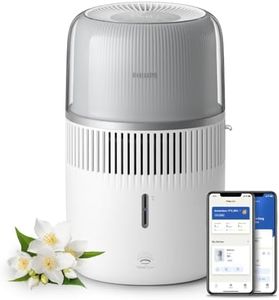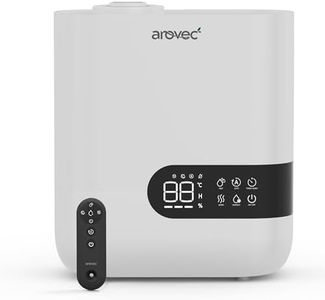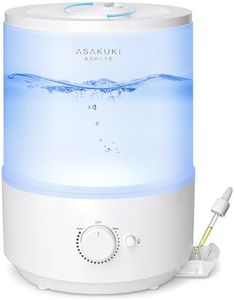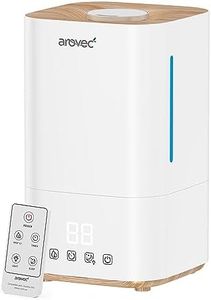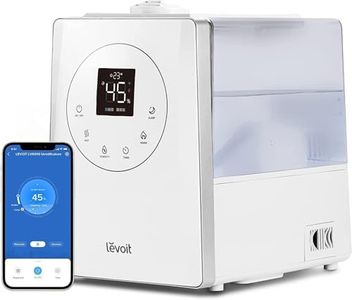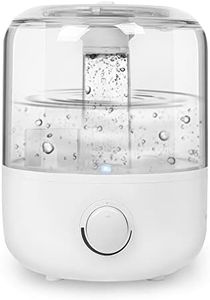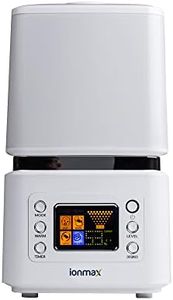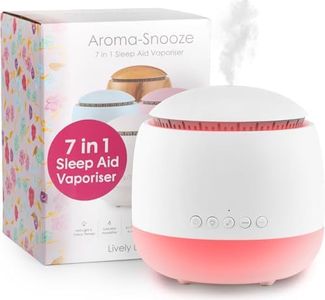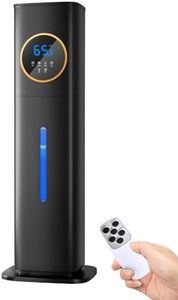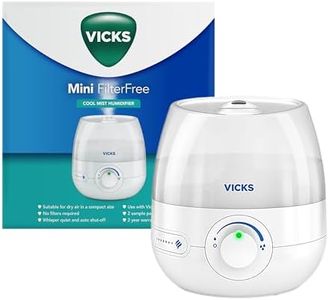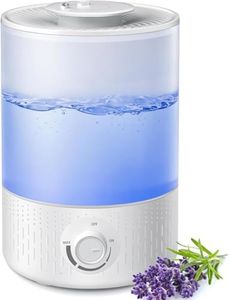We Use CookiesWe use cookies to enhance the security, performance,
functionality and for analytical and promotional activities. By continuing to browse this site you
are agreeing to our privacy policy
10 Best Cool Mist Humidifiers
From leading brands and best sellers available on the web.Buying Guide for the Best Cool Mist Humidifiers
When choosing a cool-mist humidifier, your goal is to improve your indoor air quality and comfort by adding moisture to dry air. It's important to consider where and how you plan to use the humidifier—whether it’s for a bedroom, a larger living room, a child's nursery, or even an office space. Think about how much maintenance you’re willing to handle, how often you want to refill the unit, the noise level acceptable to you, and any specific health needs. Understanding the main specifications will help you match a humidifier to your environment and ensure you enjoy the benefits of healthier air without unnecessary hassle.Room Coverage AreaRoom coverage area shows how much space (measured in square feet or meters) a humidifier is designed to effectively serve. This spec matters because a unit that’s too small will struggle to maintain humidity levels, while one that’s too big may waste energy and potentially over-humidify the space. Humidifiers are usually grouped into small (under 300 sq. ft.), medium (up to 500 sq. ft.), and large (over 500 sq. ft.) coverage areas. Assess the size of the room where you’ll use the humidifier—measure it if you're unsure—then pick a model rated for at least that much space for optimal performance.
Water Tank CapacityWater tank capacity tells you how much water the humidifier holds before it needs a refill. It impacts how long the unit can run between fills—larger tanks mean longer operation, smaller ones need more frequent refilling. Typical capacities can range from about 0.5 liters (for desktop models) up to several liters (for whole-room use). If you want a device that can run overnight or for most of the day without attention, look for a larger tank, but keep in mind that bigger tanks may make the unit bulkier and heavier.
Mist Output RateMist output rate (sometimes listed as output per hour) shows how much moisture the humidifier can add to the air over a set time. This is important because it affects how quickly a room reaches your desired humidity. Low-output models suit personal spaces or occasional use, while higher output is better for continuous or larger-area humidification. Most users benefit from adjustable output settings—so you can fine-tune the mist level based on room size, dryness, and sensitivity preferences.
Noise LevelNoise level describes how much sound the humidifier creates while running, usually measured in decibels (dB). This matters if you plan to use the humidifier in a bedroom, nursery, or workspace where quiet is important. Humidifiers generally fall into quiet (often below 35 dB), moderate (35–50 dB), or louder ranges (above 50 dB). For sleeping areas and studies, prioritize quieter models, while in living rooms or large areas, sound may be less critical.
Filter Type and MaintenanceSome cool-mist humidifiers use replaceable filters or wicks to trap minerals and impurities, while others are filter-free. Using a filter helps reduce white dust and improves air quality but means regular replacements and added costs. Filter-free options are easier to maintain but may require more frequent cleaning or can produce mineral dust if using hard tap water. Decide if you’d prefer lower maintenance costs with regular cleaning, or the convenience and air quality benefits of filtered units, and check how easy it is to access and clean parts for ongoing hygiene.
Humidity Controls and FeaturesHumidity controls let you set and regulate the desired moisture level, either through manual adjustments or built-in sensors (humidistats). Extra features might include timers, night lights, automatic shut-off, and remote control. Manual models are simple and affordable, while models with digital displays and automatic sensors offer effortless precision. Consider which features fit your lifestyle—essential if you want ‘set and forget’ usage, or if you want more control over your environment.
Ease of CleaningEase of cleaning is crucial because regular maintenance prevents mold or bacteria from growing inside the unit. Look for humidifiers with wide openings, removable tanks, and simple component layouts, which make cleaning quick and thorough. If you foresee cleaning often being a chore, prioritize models designed to be easy to disassemble and clean, as this will help keep the humidifier running efficiently and safely.
